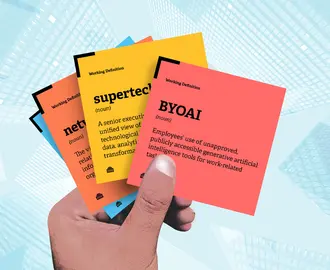Credit: SoulCycle
Upgrading a company’s 500 computers and onboarding its 2,500 employees is bound to cause glitches. For SoulCycle — the indoor cycling studio that’s achieved cult status among fitness fans — the toughest growing pain during its IT update this year was the absence of a Caps Lock button on the new Google Pixelbooks purchased for retail and daily operational needs.
The company prides itself on outsized enthusiasm, so there are a lot of all-caps emails and messages. Having to use a shortcut instead of a single laptop key to digitally express that emotion was not a popular change, explained Michael Urcinoli, SoulCycle’s vice president of business technology, during the 2019 MIT Sloan CIO Symposium.
Given the short timeframe for the rollout, not to mention the day-of logistics, the company might have gotten off easy with a keyboard quirk as the topmost complaint.
In January, Urcinoli and his team began the upgrade of every point of sale machine — including the wires and legacy accessories that came with them — in every SoulCycle studio in the United States. The catch? Each upgrade had to be done in the 2-3 hour window between the studios’ morning and evening classes.
“The studio staff would run the business on their legacy computers for their morning check-in, and their evening check-in was an entirely new ecosystem of hardware,” Urcinoli said. “Everything soup to nuts; everything looked different. We did this with one person per location in charge of redoing all this stuff. Imagine starting and ending your day on different platforms. It's insane, but I promise you it's possible.”
Here are three takeaways from SoulCycle’s insanely possible upgrade.
Recruit high performers to help spread the word
Getting buy-in for the upgrade was easy enough from the tech side of things, Urcinoli said, but from a culture perspective, there needed to be some momentum.
“So we put the devices into hands of people that you would associate with momentum,” Urcinoli said. “We gave it to high performers, we gave it to long-tenured employees, people in big job roles and responsibilities, people that other people looked up to.”
If someone noticed a coworker using a new device during a meeting, that helped to spark conversation and spread the word about what was to come.
A short execution requires long preparation
While a 3-hour deployment was very fast, the reason SoulCycle was able to do that was the result of long preparation time, Urcinoli said.
Urcinoli’s team started with SoulCycle’s West Village studio in Manhattan – the one closest to the company’s New York City headquarters — to get an idea of what the upgrade and deployment would be like in practice.
He also hired a director to make a series of short, in-house movies for employees to get a sense of how the upgrade would impact not only their daily work, but the future of the company as a whole.
“You’re not just changing the device that the ends of the cables plug into, you're changing how people work, you're changing a large portion of their day,” he said.
Get your partners involved early
SoulCycle doesn’t offer memberships, instead, riders pay each time they sign up for a class. That means a high number of credit card transactions for each studio every day, Urcinoli said.
It also means SoulCycle must meet security standards for companies that handle credit card transactions.
Urcinoli said his team partnered with global accounting firm RSM to work out how SoulCycle’s new technology would work with traditional IT controls, “to make sure that at the end of the year everyone’s satisfied, all the auditors are happy, every box was checked, and no one can say ‘You didn’t think of this.’”



